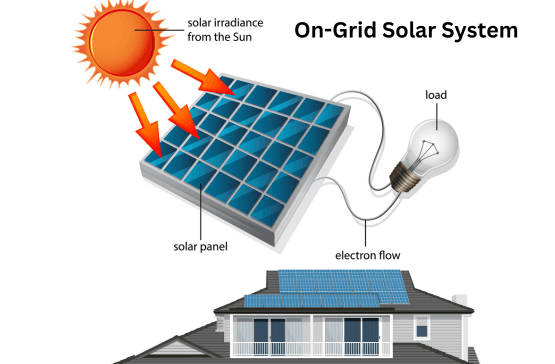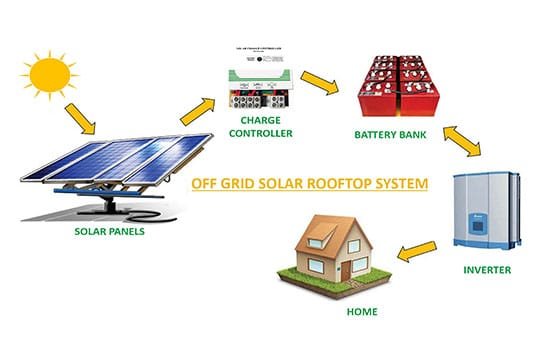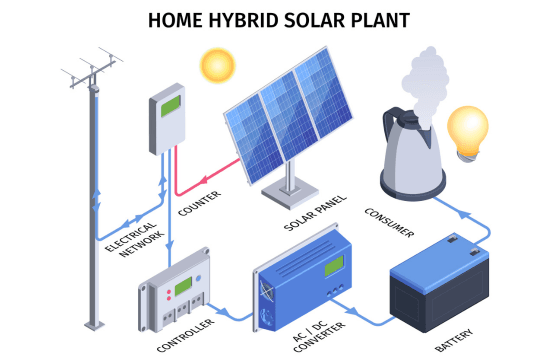Commercial Solar Energy Systems
Synergy Solar, we specialize in providing tailored solar energy solutions for commercial spaces. Our expert team works with you to assess your energy needs, design an efficient system, and handle the entire installation process. Future-proof your business with custom commercial solar installations—cut energy costs, improve sustainability, and gain energy independence.

A Commercial Solar System is a photovoltaic (PV) setup designed to generate electricity for business establishments such as offices, retail complexes, hospitality venues, and educational institutions. These systems offer a scalable, eco-friendly energy solution that allows businesses to take control of their power supply and optimize operational efficiency.
Components of commercial solar projects
Battery Storage
Mounting Structure
Inverter
Solar Panels
Electrical Wiring and Safety Equipment
Grid Connection (for Grid-tied Systems)
Monitoring System
Electrical Wiring and Safety Equipment
Types of Commercial Solar Systems
On-Grid Solar System
An On-Grid Solar System is a solar setup connected to the utility grid, generating power during the day and sending excess energy back to the grid without needing batteries. It helps lower electricity bills through Gross Metering or Net Feed-in (as per state policy).

Applications of commercial solar energy solutions
Office Buildings & Business Parks
Shopping Malls & Retail Chains
Hotels, Resorts & Hospitality Venues
Private Schools, Colleges & Educational Institutions
Private Healthcare Clinics & Hospitals
Apartment Complexes & Commercial Real Estate
Banks & Financial Institutions
Government & Municipal Buildings (non-industrial)
Supermarkets & Grocery Chains
Benefits of Commercial Solar Power for Your Business
Drastically Lower Electricity Bills
Reduce electricity expenses by up to 70%, allowing you to redirect those savings into business growth, operations, or innovation.
Fast Payback, Long-Term ROI
Commercial solar systems typically offer payback in 5–7 years, delivering 20+ years of free power and an impressive ROI.
Energy Independence & Reliability
Protect your business from power outages and price hikes with consistent energy availability, especially with hybrid and off-grid systems.
Competitive Business Advantage
Going solar strengthens your market positioning. Modern consumers and B2B clients prefer sustainable, forward-thinking businesses. Solar adoption enhances your brand value, corporate image, and even client trust.
Boosted Property Value
Solar-powered commercial buildings are seen as premium assets. Whether you lease or sell, properties with solar offer long-term value and appeal.
Sustainability & Green Branding
Demonstrate leadership in sustainability by cutting CO₂ emissions by up to 50%. Showcase your commitment to the environment and align with ESG goals.
Low Maintenance, Long Lifespan
Solar systems are built to last with 25+ year warranties and require minimal upkeep. That means lower operational headaches and long-term reliability.
Scalable & Future-Ready
Whether you’re a small enterprise or a large industrial unit, solar systems are scalable and customizable to meet your energy demands now and as you grow.
Commercial Solar Plant Specifications
Solar Capacity
50 kW to 1 MW, depending on the energy needs of the facility.
Battery Capacity
100 kWh to 500 kWh (expandable based on requirements)
Inverter Rating
50 kW to 500 kW, depending on the system size.
Peak Efficiency
97-99% efficiency for inverters and solar modules
Energy Storage Type
Lithium-ion or advanced lead-acid batteries.
Backup Generator Compatibility
Integrated diesel or natural gas generators can be used for backup power.
Monitoring
Real-time monitoring with performance data, accessible remotely via a web platform or mobile app.
Financial and Environmental Impact
Cost Savings:
The initial investment in hybrid solar can be recouped through savings on energy bills within 5-7 years. Long-term cost reductions, especially when grid power is expensive, make it a wise investment for industries.
Return on Investment (ROI)
Depending on the scale of the system and the energy demands, industries can expect an ROI of around 10-20% annually.
Carbon Footprint Reduction
By adopting renewable energy, industries can cut their CO2 emissions by 30-50%, contributing to sustainable development goals.
Commercial Solar Panel Installation Process
Energy Audit & Site Survey
Grid Connection & Approvals
Custom Design & Proposal
Performance Monitoring Setup
Installation by Certified Experts
After-Sales Support & Maintenance
Loan & EMI Options Available for Commercial Solar
You don’t need to delay your solar installation due to upfront costs. Flexible loan and EMI options are available through many leading banks and financial institutions, making it easier for businesses to adopt solar without full payment in hand.
These financing options allow you to spread the investment over time, so you can start saving on your electricity bills immediately while paying in manageable monthly installments.
✅ Key Highlights:
- Loan tenure typically ranges from 3 to 7 years
- Minimal down payment may be required (varies by lender)
- Available through nationalized and private banks / NBFCs
- EMI options designed for commercial entities, institutions, and real estate owners
📄 Documents Commonly Required for Solar Loan Applications:
- Business registration documents (GST, Udyam, MSME, etc.)
- PAN card of the business and authorized signatory
- Last 6 months’ bank statements
- Latest ITR (Income Tax Return) filings
- Address and identity proof (business and signatory)
- Project proposal / solar quotation with system specs
- Utility bill of the site (electricity)
Why Choose Us for Commercial Solar System Installation
Commercial Solar Experts – Specialized in business-scale solar installations
End-to-End Service – From site survey to system commissioning
Smart Monitoring – Real-time performance tracking included
Tailored Solutions – Custom-designed systems to match your energy needs
Premium Components – Tier-1 panels, certified inverters, and durable structures
Nationwide Service – We deliver and install across all of India
Frequently Asked Questions (FAQs) – On-Grid Home Solar System
1.How much does a commercial solar system cost in India?
Costs vary depending on the system size, location, and installation type. On average, a commercial rooftop solar system may cost around ₹40–₹60 per watt. For example, a 100 kW system could cost between ₹40–₹60 lakhs.
2.How many solar panels are needed for a commercial building?
It depends on your building’s energy usage. For example, a 100 kW solar system typically requires around 250–300 solar panels (depending on panel wattage). A professional site audit can determine the exact number.
3.What is the lifespan of a commercial solar power system?
Most commercial solar systems last 25 years or more with proper maintenance. Inverters typically last 10–15 years and may require replacement during the system’s life cycle.
4.Is government subsidy available for commercial solar projects?
Currently in India, central subsidies are focused on residential rooftop systems. However, some states offer incentives or exemptions for commercial installations. Check with local DISCOMs or state renewable agencies for details.
5.Can I run a commercial building entirely on solar power?
Yes, with a properly sized off-grid or hybrid solar system, your building can operate independently from the grid. Battery storage is essential for full off-grid performance and night-time usage.
6.Do commercial solar systems work during power outages?
Only off-grid and hybrid systems provide backup during outages. On-grid systems shut down during blackouts for safety reasons unless integrated with batteries.



